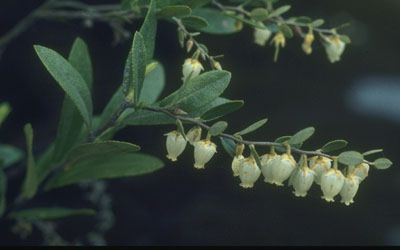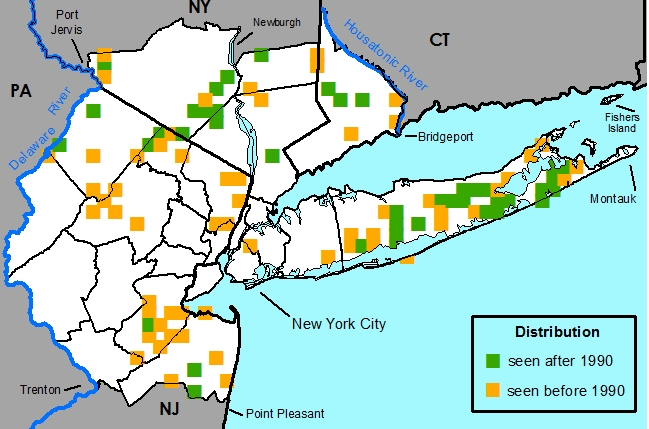Chamaedaphne calyculata (L.) Moench - Leatherleaf

Leatherleaf
Photo © Peter Nelson, 1970, taken in the New Jersey pine barrens.Native , Occasional
By Steven Clemants
Not peer reviewed
Last Modified 04/08/2013

Common Names
LeatherleafField Identification
A wetland shrub with orange-scaly, evergreen leaves and white flowers.Food uses
Disclaimer: The information provided here is for reference and historical use. We do not recommend nor do we condone the use of this species for food purposes without first consulting a physician.(Lewis & ElvinLewis, 1977) (Uphof, 1968)
A tea was made from the fresh and dried leaves by the Ojibwa.
Nomenclature
*Andromeda calyculata L., Sp. Pl. 1: 394. 1753. *Chamaedaphne calyculata (L.) Moench, Methodus 457. 1794. *Lyonia calyculata (L.) Rchb., Fl. Germ. Excurs. 1: 414. 1831. *Cassandra calyculata (L.) D. Don, Edinburgh New Philos. J. 17: 158. 1834, nom. illeg. (Art. 52.1). TYPE: Type not designated, probably five elements.*Andromeda calyculata var. latifolia Aiton, Hort. Kew. 2: 70. 1789. *Chamaedaphne calyculata var. latifolia (Aiton) Fernald, Rhodora 47: 390. 1945. *Cassandra calyculata var. latifolia (Aiton) F. Seymore, Fl. N. England p. 431. 1969, nom. illeg. (Art. 52.1). TYPE: Canada. Newfoundland: collector unknown (Holotype: BM?). [broadly rounded leaves, 1-3 cm long]
*Andromeda calyculata var. angustifolia Aiton, Hort. Kew. 2: 70. 1789. *Andromeda angustifolia (Aiton) Pursh, Fl. Amer. Sept. 1: 291. 1814. *Cassandra calyculata var. angustifolia (Aiton) A. Gray, Syn. Fl. N. Am. 2,1: 35. 1878., nom. illeg. (Art. 52.1). *Chamaedaphne calyculata var. angustifolia (Aiton) Rehder in Bailey, Cycl. Am. Hort. 1: 287. 1900. *Chamaedaphne angustifolia (Aiton) Spach in Beissn. et al., Handb. Landholzben. 391. 1903, nom. inval. (Art. 34.1c). TYPE: Type not designated, probably three elements. [narrow leaves]
*Andromeda calyculata var. ventricosa Aiton, Hort. Kew. 2: 70. 1789. TYPE: Russia. Location unknown, collector unknown (Holotype: BM?).
*Andromeda calyculata var. anomala Vent., Jard. Malmaison 2: t. 80. 1804. *Cassandra angustifolia var. anomala (Vent.) DC., Prodr. 7(2): 610. 1839, nom. illeg. (Art. 52.1). TYPE: France. Cels garden: collector unknown (Holotype: G?).
*Andromeda calyculata var. nana Sims, Bot. Mag. 32: t. 1286. 1810. *Chamaedaphne calyculata var. nana (Sims) Rehder in Bailey, Cycl. Amer. Hort. 1: 287. 1900. *Cassandra calyculata var. nana (Sims) Bean, Trees Shrubs Brt. Isles 1: 302. 1915, nom. illeg. (Art. 52.1). TYPE: Type not cited. [decumbent stem, rounder, somewhat more toothed leaves, and shorter racemes]
*Andromeda calyculata var. linearis Sims, Bot. Mag. 32: t. 1286. 1810. TYPE: Type not cited. [smaller greenish flowers, narrow pointed calycine leaves, more erect branches, nearly linear dark-colored leaves with undulate reflexed margins]
*Andromeda crispa Desf., Hist. Arb. France 1: 258. 1809. *Chamaedaphne crispa (Desf.) Spach, Hist. Nat. Vég. 9: 477. 1840. *Lyonia calyculata f. crispa (Desf.) Zabel in Beissn. et al., Handb. Landholzben. 391. 1903. TYPE: North America. Desfontaine s.n. (Holotype: FI?).
¤Cassandra dahurica Grum-Grzhim. & Semen., Opis. Amursk. Obl. 287. 1894, nom. inval. (Art. 32.1c)?
Description
HABIT perennial, evergreen, chamaephyte, shrubs, autotrophic, monoclinous, with fibrous roots, 0.3-1.5 m tall, not modified.STEMS decumbent or ascending, round, not winged, "regular". Prickles absent. Bark smooth or fibrous, exfoliating, orange-yellow or dark orange-yellow. Branches ascending, orange-red, round, not winged, 1.6-1.8 mm in diam. Twigs orange-red, not odoriferous, round, 0.7-0.9 mm in diam., smooth, with sessile scales and hairs short and unbranched, appressed, unicellular and multicellular, uniseriate, orange-yellow or gray or white, moderately dense, throughout, not glabrescent, without glands, two types of hairs present. Pith present, light yellowish orange or light orange-yellow, round, continuous. Thorns absent. Aerial roots absent. Sap translucent. Resin absent.
LEAVES alternate, 1 per node, spaced ± evenly along stem, divergent from stem, simple. Stipules absent. Leaves petiolate, petiole "typical", 0.1-0.3 cm long, hairs short and unbranched and with sessile scales, appressed or erect, unicellular (short hairs) or multicellular (scales), uniseriate (short hairs) or multiseriate (scales), moderately dense, throughout, not glabrescent, without glands. Leaf: abaxial surface dark orange-yellow, adaxial surface yellowish green, blades linear triangular or oblanceolate or elliptic or obovate, plane, symmetric, 1.8-4.1 cm long, 0.4-1.5 cm wide, chartaceous, base cuneate, margin minutely serrate or crenate, apex obtuse, abaxial surface with sessile scales, appressed, multicellular, multiseriate, orange or white, dense, throughout, not glabrescent, without glands, adaxial surface with sessile scales, appressed, multicellular, multiseriate, orange, dense, throughout, not glabrescent, without glands. Eucamptodromous venation, veins 5 (obscure). Leaf lobes absent. Spines absent. Tendrils absent.
INFLORESCENCES monomorphic, regular or, if dimorphic, female inflorescence simple, raceme, terminal. Peduncle absent. Rachis present, 2.5-10.5 cm long, with bracts. Bracts sessile, blades: abaxial surface light yellowish green, adaxial surface light yellowish green, narrowly elliptic or oblanceolate or elliptic or obovate, explicative, 6-20 mm long, 3-6 mm wide, base obtuse, margin serrulate, apex obtuse, abaxial surface with sessile scales, abaxial hairs appressed, multicellular, orange or white, moderately dense, throughout, not glabrescent, without glands, adaxial surface with sessile scales, appressed, multicellular, orange, dense, throughout, not glabrescent, without glands. Pedicel 1.5-3 mm long, with sessile scales, hairs appressed, multicellular, orange or white, dense, throughout, not glabrescent, without glands. Bracteoles 2, sessile, at apex of pedicel, not connate, bracteoles: abaxial surface orange-yellow, bracteole: adaxial surface orange-yellow, depressed ovate or shallowly triangular, curved (upward), 1.3-1.6 mm long, 1.6-2 mm wide, base cordate, margin ciliate, apex acute. Cupules absent.
FLOWERS serotinous, formed on long shoots, monomorphic, with sepals and petals readily distinguishable from one another, bisexual, flowers white, 5-merous, 6.6-7.6 mm long, 2.5-4 mm wide, 10-15 flowers per inflorescence, perianth of two whorls. Calyx present, actinomorphic, of free sepals, persistent, abaxial and adaxial surfaces the same color, light yellowish green, uniform, 1.6-2.3 mm long, 1.1-1.4 mm wide. Sepals or sepal lobes 5, rhombic, 1.6-2.5 mm long, 1.1-1.9 mm wide, base truncate, margin ciliate, apex acute, abaxial surface with sessile scales, appressed, multicellular, orange or white, moderately dense, throughout, not glabrescent, without glands, adaxial surface glabrous, without glands. Epicalyx absent. Corolla present, actinomorphic, of fused petals, deciduous, abaxial and adaxial surfaces the same color, white, uniform, 5-6 mm long, 2.5-3 mm wide, corolla limb 10-11 mm long, 1.9-2.5 mm wide. Petals or petal lobes 5, trullate, 1-1.1 mm long, 0.7-0.9 mm wide, base truncate, margin entire, apex obtuse, abaxial surface glabrous, without glands, adaxial surface glabrous, without glands. Gynoecium syncarpous. Carpels 5. Stigmas 1, capitate. Styles persistent, 1, 4-5.1 mm long. Ovary superior, 0.5-1 mm long, 0.9 mm wide, nectiferous disk present. Locules 5. Placentation axile. Androecium obdiplostemonous. Stamens 10, 4.2-4.5 mm long. Anthers linear, opening by pores in terminal tubes, opening 1/4 of entire anther, bithecal, reddish orange, glabrous. Filaments free, straight, dark reddish orange, glabrous. Staminodes absent.
FRUITS septicidal capsule, dark reddish violet, turbinate, 2.2-3.5 mm long, 2.2-3.6 mm wide, glabrous, without glands.
SEEDS many, yellowish orange or orange-yellow, wedge-shaped, 0.7-1 mm long, 0.5-0.8 mm wide, wingless, not tailed, reticulate-foveate.
Habitat
(Gates, 1942) (Reschke, 1990) (Wherry, 1920) (Wherry, 1920)
Bogs, swamps, lake and stream margins. Pine barrens vernal ponds, pine barrens shrub swamps, inland poor fens, and dwarf shrub bogs. Chamaedaphne calyculata is the dominant species in shrub associations on some bogs. It is often associated with Carex lasiocarpa, Andromeda glaucophylla, Rhododendron groenlandicum, Kalmia polifolia, Vaccinium oxycoccus, Sarracenia, and Drosera. It usually grows on wet sphagnum mats over water. The soil is wet (or occasionally dry) peat with a pH of 4.5-6.
Rarity Status
Heritage rank -- G5Connecticut -- not listed
New Jersey -- not listed
New York -- not listed
Species Biology
Flowering(March [week 3]) April [week 3] - May [week 4] (June [week 3]).
Pollination
(Grevillius & Kirchner, 1923) (Heinrich, 1976) (Lovell & Lovell, 1935) (Reader, 1975) (Reader, 1977) (Small, 1976) (Warming, 1908)Autogamy -- Self-pollination is possible but usually not very effective.
Melittophily -- Andrena bradleyi Vier., A. cressonii Robt., A. sigmundi Cockerell, A. vicina Sm., Bombus affinis Cr., B. bimaculatus Cr., B. fervida (F.), B. griseocollis (DeG.), B. impatiens Cr., B. ternarius Say, B. terricola Kby., B. vagans Sm., and Colletes inaequalis Say are the most common floral visitors.
Other -- The flowers are visited by a number of other insects including flies, butterflies, and beetles.
Fruiting
June [week 3] - Nov [week 4] (Jan [week 4]).
Dispersal
Anemophyly -- Probably wind.
Germination
Unknown.